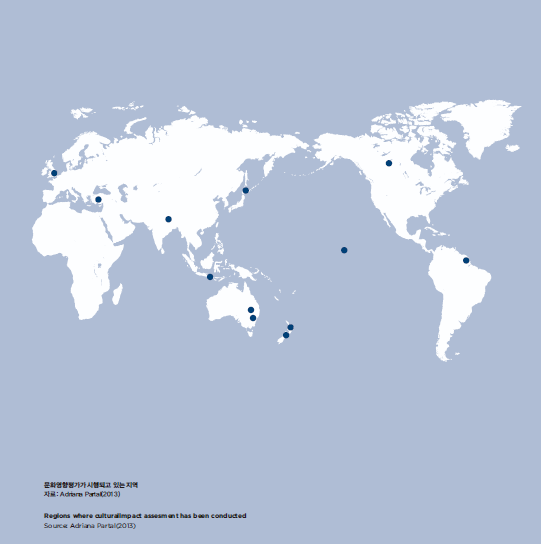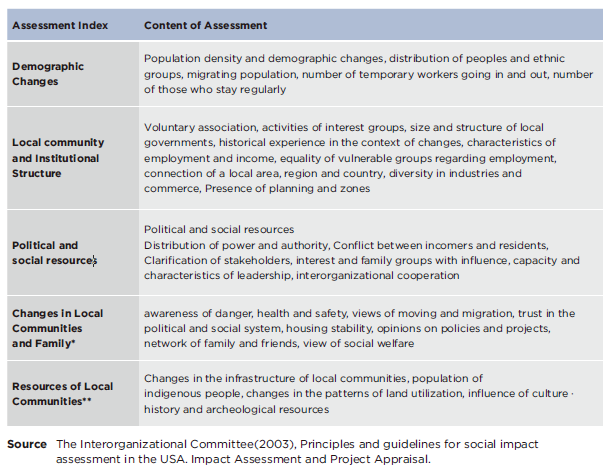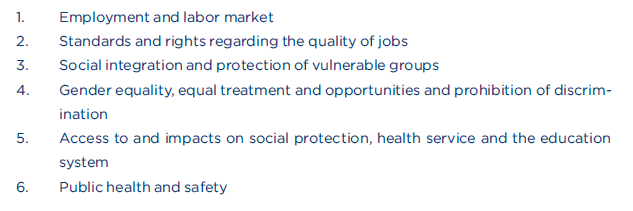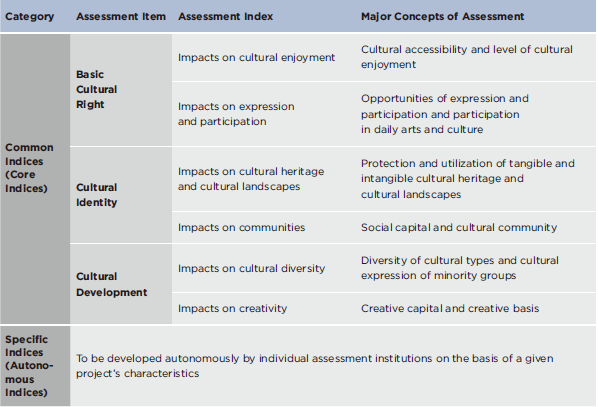경기문화재단
Present and Future of Cultural Impact Assessment Viewed from the Perspective of International Trends
Cultural Policy is a quarterly magazine published by the Gyeonggi Cultural Foundation since the summer of 2017 with the purposes of identifying new trends in cultural policies at home and abroad, gathering the opinions of experts in relevant areas, and introducing the directions and contents of diverse cultural policies promoted by Gyeonggi Provincial Government and Gyeonggi Cultural Foundation. |
Writer | Yang Hye-won
Cultural impact assessment has been known globally as a “future-oriented
means that helps policymakers improve positive impacts of policy on values,
beliefs, thoughts, ideology, ethics, habits, tradition and other material
and immaterial environments while enabling them to mitigate and reduce negative
impacts.” (Partal, 2013). A. Partal explains that cultural impact assessment has been
implemented mostly in Australia, New Zealand, northern Japan, Hawaii and Canada
where indigenous communities are active.1) However, the scope and prospect of cultural
impact assessment seem to further expand recently.
This paper attempts to look into the future of cultural impact assessment by studying cases of cultural impact assessment in different countries, diverse efforts to assess cultural impacts and the current state of cultural impact assessment that is currently carried out in Korea in 2017.

Cultural Impact Assessment of New Zealand’s Auckland Council 2)3)
New Zealand’s Auckland Council conducts cultural impact assessment in order to keep track of cultural values, interests and connections formed by Mana Whenua, local indigenous people, in their relationship with the region and natural resources. The assessment system then studies what impacts development projects have on such cultural elements and how to mitigate negative impacts. If a developer plans to launch a project in an area that is valuable for Mana Whenua or in the vicinity of an archaeological site and a zone with a great natural landscape or characteristics, the developer is required to go through cultural impact assessment. It is indigenous people who conduct such assessment. Meanwhile, the Auckland Council gives support by coordinating the assessment process, providing information and suggesting recommendations.
Cultural Impact Assessment of Canada’s Mackenzie Valley 4)5
The Mackenzie Valley, which is located in Canada’s Northwest Territories, has come up with strategies to understand and minimize development projects’ negative impacts on Mackenzie Valley’s cultural environment (tangible cultural heritage, sites that are meaningful spiritually, historically and socially, methods of crop cultivation and land utilization, cultural landscape in a broad sense encompassing local culture, identity and values, system of cultural values, expression and knowledge, etc.). The framework of such strategies is environmental impact assessment which includes cultural impact assessment. The assessment takes place in three steps: preliminary screenings, environmental assessment and environmental impact review. To be more specific, cultural impact assessment is composed of the following six steps

The Mackenzie Valley Environmental Impact Review Board (hereinafter referred to as the Review Board) reviews a project and requests the developer to stop it in the following cases :

Social Impact Assessment in the US and Integrated Impact Assessment in the EU
It is also worth comparing social impact assessment in the US and integrated impact assessment in the EU to cultural impact assessment. Social impact assessment in the US is a system that “assesses the impacts of development projects or policies on local residents and local communities.” It has been conducted since 2003. Its major elements of assessment are cultural values or characteristics such as the cultural identity of the given local community or people, which cannot be assessed only with environmental impact assessment.





The purposes of cultural impact assessment are to improve cultural values and to suggest better cultural alternatives by assessing the cultural impacts of public policies. Such assessment is not only a system of assessing a country’s policies but it is humanity’s common duty as the system’s meaningfulness has been recognized globally. Still, the design and management of the system may differ depending on each country’s historical, social and cultural contexts. Furthermore, the development of the system will require sustainable international cooperation and networking efforts.
Citation
1) Adriana Partal (2013) Impact Assessment: A Tool to Assist Cultural Sustainable Development. People and the Planet 2013 Conference: Trasforming the Futrue, RMIT University, Melbourne, Australia, 2-4 July
2) Ministry of Culture, Sports and Tourism of Korea (2015). 2015 Research on Cultural Impact Assessment.
3) Auckland Council. Mana Whenua Cultural Impact Assessments, Proposed Auckland Unitary Plan: Fact Sheet
4) Ministry of Culture, Sports and Tourism of Korea (2015). 2015 Research on Cultural Impact Assessment.
5) Mackenzie Valley Review Board (2012), Cultural Impact Assessment Guidelines:/ Internal Working Draft (internal document not to be distributed outside), p. 51.
6) Ministry of Culture, Sports and Tourism of Korea(2016) The 2016 Comprehensive Report on Cultural Impact Assessment.
7) Korea Culture & Tourism Institute (2017), The 2017 Guidelines on Cultural Impact Assessment.
8) The Future We Want Includes Culture (2015), Recognizing the Role of Culture to Strengthen the UN Post-2015 Development Agenda
Cultural Policy Bulletin Vol.1 E-book
<ggc의 모든 콘텐츠는 저작권법의 보호를 받습니다.>
세부정보
Writer - Yang Hye-won/ Researcher at Statistics & Evaluation Center of Korea Culture & Tourism Institute
- 글쓴이
- 경기문화재단
- 자기소개
- 경기 문화예술의 모든 것, 경기문화재단